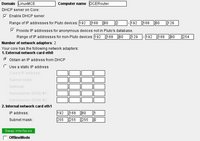Network Settings
The settings on this page are used to configure the network in your Core.
Recommended configuration
The recommended configuration for a LinuxMCE Core is to have 2 network cards, and plug 1 of them into the external internet (the cable or DSL modem), and the other into the internal switch that the other computers and devices in the house connect to. This allows the LinuxMCE Core to act as a firewall to protect the devices in the house, and also to manage your network bandwidth to ensure that phone calls, video calls and other time-sensitive traffic take priority over web pages and file downloads. In such a configuration you would enable DHCP on the internal network, and the external network would obtain an IP address either statically or through the DHCP server in your DSL/Cable modem, depending on how your internet service provider configured it.
Every device connected to the local area network in your home needs a unique IP address. The "DHCP Server" is the device that assigns every other device its own IP. If you have multiple computers in your home, you probably have a router, DSL or cable modem that is your DHCP Server. Normally you should only have 1 DHCP server on the network. If you have more than 1, they can 'fight' over the assignment of IP addresses. If you have dual network cards in the Core, this solves the problem since the 'external' internet connection provided by your DSL or cable modem is physically a separate network from the internal network in your home. In that case, it is okay to have LinuxMCE act as the DHCP server for the internal network, while the Cable/DSL modem is the DHCP server for the external network.
Diskless media directors
If you want to have diskless media directors, where they do not boot LinuxMCE from their local hard drive, but rather use the LinuxMCE Core, the Core needs to be the DHCP server for those media directors. Also, for the Core to be able to automatically configure your devices, such as telephones, the Core needs to be their DHCP server. The easiest solution is, therefore, to make the Core the sole DHCP server in your house. It will then assign IP addresses for every computer in your home, whether it's running LinuxMCE's software or not.
Single network card
If you do not have dual network cards, or want to use another DHCP server, you can disable DHCP on the LinuxMCE Core altogether. Or, you can tell the Core to "give IP addresses to LinuxMCE devices only". This means the LinuxMCE Core will assign IP addresses for LinuxMCE devices, but ignore everything else in your home. If you do this, LinuxMCE can work with your other DHCP servers if they likewise do not try to assign IP addresses to your LinuxMCE devices. But this means that plug-and-play will not work since LinuxMCE will only give IP addresses to devices it already knows--not new devices.
Example configuration
If you do not have two network cards, and want your existing homenetwork to remain using your DSL-Modem/Router/WLANAcessPoint-All-in-One-Standalone-Box (e.g. a Fritzbox) you`ll end up with two subnetworks in your home. - Or you manage to tell the Core to only use 1 subnetwork, which I didn`t ...
If this is the case your existing network most likely contains a "DSL-Modem/Router/WLANAcessPoint" (192.168.1.1) which connects your local Computer (192.168.1.2) and your Laptop (192.168.1.3) to your Internetprovider (which assigns a dynamic Internet-IP to your Router).
! You need to disable the DHCP-Sever in the "DSL-Modem/Router/WLANAcessPoint". Assign static IPs to all your homenetwork-computers. Later on everytime a computer/device which uses dhcp is started, the dhcp-request must be answered by the core/hybrid in order to use MD pxe boot.
Now you install a Core/Hybrid with one physical networkcard (eth0). LinuxMCE automatically adds a second virtual networkcard (eth0:0). Change your "external" IP to be static and to be part of your existing homenetwork (e.g. IP 192.168.1.4). So far I`m only telling old stories ... The particular NEWS: To use your existing wiring (incl. wlan) you need to tell the router that the gateway to the "external" (from the homenetwork`s point of view) (sub)net 192.168.80.0 is 192.168.1.4 This is done by creating a static route on your "DSL-Modem/Router/WLANAcessPoint". Sometime you`ll find this in the NAT-settings. If using a Fritzbox: System / Networksetting / IP-Routs / Add. IP-network: 192.168.80.0 Subnetmask: 255.255.255.0 Gateway: 192.168.1.4
Hint: If you disabled the dhcp-server of the "DSL-Modem/Router/WLANAcessPoint" and created the route before installing LinuxMCE you`ll end up with an internal-eth0:0 192.168.80.1 and your external-eth0 (which uses "Obtain an IP adress from DHCP") having an IP from the subnet 192.168.80.xxx as well. This means everything is working! Your "external" interface did ask for a dhcp-server and your "interal" interface answered that it got one ... - Of course you have to change your "external"-eth0-IP to be static and be part of you (sub)homenetwork, as well.
